Quick Look
Grade Level: 7 (6-8)
Time Required: 1 hour
Expendable Cost/Group: US $5.00
Group Size: 28
Activity Dependency:
Subject Areas: Measurement, Number and Operations, Science and Technology
NGSS Performance Expectations:

| MS-ETS1-4 |
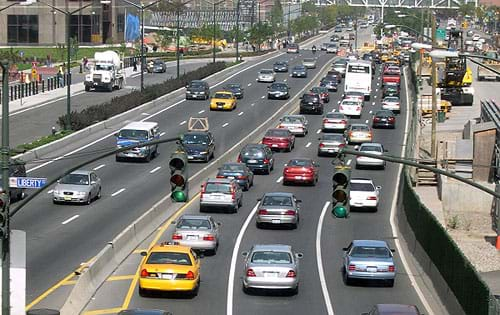
Summary
Students construct a model roadway with congestion and apply their knowledge of level of service (LOS) to assign a grade to the road conditions. The roadway is simply a track outlined with cones or ropes with a few students walking around it to mimic congestion. The remaining students employ both techniques of density and flow to classify the LOS of the track.Engineering Connection
Traffic congestion is estimated to have caused ~700 million person hours of delay per year in the early 1980s, more than 2 billion hours of delay in the 1990s, and nearly 3.5 billion hours of delay by 2000. The costs of congestion—time delay costs, reduced productivity and opportunity, environmental impacts, etc.—are approaching $100 billion a year, and continue to rise. With so many roads in disrepair, engineers use LOS to determine priorities for allocating limited funding for roadway improvements.
Learning Objectives
After this activity, students should be able to:
- Describe congestion and its levels.
- Calculate traffic density and flow.
- Evaluate congestion through LOS.
- Identify the impacts of congestion.
- Classify roadways with LOS.
Educational Standards
Each TeachEngineering lesson or activity is correlated to one or more K-12 science,
technology, engineering or math (STEM) educational standards.
All 100,000+ K-12 STEM standards covered in TeachEngineering are collected, maintained and packaged by the Achievement Standards Network (ASN),
a project of D2L (www.achievementstandards.org).
In the ASN, standards are hierarchically structured: first by source; e.g., by state; within source by type; e.g., science or mathematics;
within type by subtype, then by grade, etc.
Each TeachEngineering lesson or activity is correlated to one or more K-12 science, technology, engineering or math (STEM) educational standards.
All 100,000+ K-12 STEM standards covered in TeachEngineering are collected, maintained and packaged by the Achievement Standards Network (ASN), a project of D2L (www.achievementstandards.org).
In the ASN, standards are hierarchically structured: first by source; e.g., by state; within source by type; e.g., science or mathematics; within type by subtype, then by grade, etc.
NGSS: Next Generation Science Standards - Science
| NGSS Performance Expectation | ||
|---|---|---|
|
MS-ETS1-4. Develop a model to generate data for iterative testing and modification of a proposed object, tool, or process such that an optimal design can be achieved. (Grades 6 - 8) Do you agree with this alignment? |
||
| Click to view other curriculum aligned to this Performance Expectation | ||
| This activity focuses on the following Three Dimensional Learning aspects of NGSS: | ||
| Science & Engineering Practices | Disciplinary Core Ideas | Crosscutting Concepts |
| Develop a model to generate data to test ideas about designed systems, including those representing inputs and outputs. Alignment agreement: | Models of all kinds are important for testing solutions. Alignment agreement: The iterative process of testing the most promising solutions and modifying what is proposed on the basis of the test results leads to greater refinement and ultimately to an optimal solution.Alignment agreement: | |
Common Core State Standards - Math
-
Fluently divide multi-digit numbers using the standard algorithm.
(Grade
6)
More Details
Do you agree with this alignment?
-
Fluently add, subtract, multiply, and divide multi-digit decimals using the standard algorithm for each operation.
(Grade
6)
More Details
Do you agree with this alignment?
-
Use ratio reasoning to convert measurement units; manipulate and transform units appropriately when multiplying or dividing quantities.
(Grade
6)
More Details
Do you agree with this alignment?
International Technology and Engineering Educators Association - Technology
-
Identify trends and monitor potential consequences of technological development.
(Grades
6 -
8)
More Details
Do you agree with this alignment?
-
Use instruments to gather data on the performance of everyday products.
(Grades
6 -
8)
More Details
Do you agree with this alignment?
State Standards
Florida - Science
-
Recognize that an object in motion always changes its position and may change its direction.
(Grade
4)
More Details
Do you agree with this alignment?
-
Investigate and describe that the speed of an object is determined by the distance it travels in a unit of time and that objects can move at different speeds.
(Grade
4)
More Details
Do you agree with this alignment?
-
Measure and graph distance versus time for an object moving at a constant speed. Interpret this relationship.
(Grade
6)
More Details
Do you agree with this alignment?
Materials List
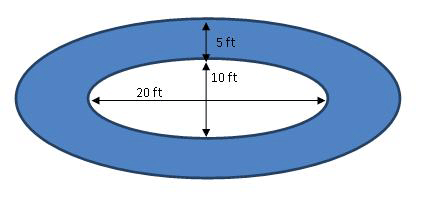
- 2 ropes (50 ft for inner ellipse and 70 ft for outer ellipse)
- 25 cones or other materials to form a track (see Figure 1 for track shape and dimensions)
- tape measure or measuring wheel
- 2 stopwatches
- paper and pencil
- calculator
- Grading Congestion Worksheet, one per student
Worksheets and Attachments
Visit [www.teachengineering.org/activities/view/usf_traffic_lesson01_activity1] to print or download.Pre-Req Knowledge
Ability to do math calculations that involve multiplication and division. Familiarity with locating points on a coordinate plane. This activity is also based on information taught in the associated lesson, What's Up with All This Traffic?
Introduction/Motivation
Year after year, while the populations of our cities have been steadily increasing, more and more people use cars to get to work. This increase in vehicles on our already-congested roadways requires engineers to identify those roads with the worst conditions so they can improve them. Engineers utilize the level of service (LOS) measure to assign roads a letter grade ranging from A to F, with A being the best and F being the worst. LOS is a measure-of-effectiveness by which traffic engineers determine the quality of travel on roadways.
A quick way to determine LOS is through density, the number of vehicles per mile per lane. As an example, consider the roadway in Figure 2, a one mile segment of I-4 near I-275 in Florida with four lanes in the eastbound direction. We know the number of lanes, four, and its length, 1 mile. The only thing left to collect is the number of vehicles going eastbound, outlined in red. With that data, we can calculate density and compare it to the Figures 3 and 4 charts. 
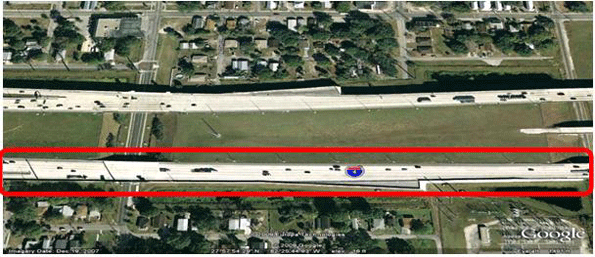
How many vehicles do you count? We put the values, including the 22 vehicles, into the equation, which gives us a density of 5.5 vehicles per mile per lane.
Taking a look at our LOS table (Figure 3), 5.5 lies between the range of 0 – 11 outline in red; therefore, this roadway segment at this particular time has LOS A.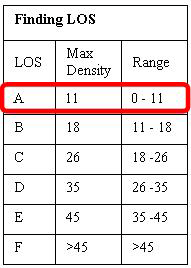
For determining LOS through flow, the number of vehicles per hour per lane, let us return to our previous example. Since we do not have a traffic counter, we can calculate flow with the average speed of the vehicles and the density of the road, which we just calculated from the previous example. Assuming an average speed of 75 mph for the interstate, we can determine flow by multiplying the average speed with density (see the associated lesson for derivation). This gives us a flow of 412.5 vehicles per hour per lane at an average speed of 75 mph. 
To determine LOS, we simply find the region where the point (flow, speed) falls on the Figure 4 graph. The region where the point (412.5, 75) lies, corresponds to LOS A, as outlined in red. This result coincides with what we obtained using the Figure 3 LOS table.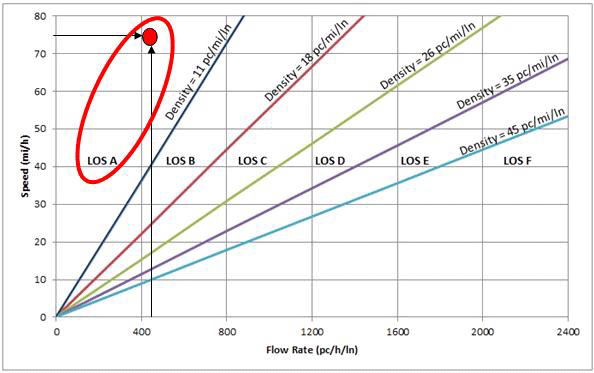
Procedure
Before the Activity
- Gather materials and make copies of the Grading Congestion Worksheet. The worksheet provides additional information to guide students through all the steps and calculations.
- Assemble students and materials at a cleared area large enough for the track and activity.
Part 1 – Data Collection
- Hand out the worksheets and form the track using ropes, cones or similar materials.
- Measure the length of the track using the tape measure or measuring wheel.
- Have a student walk leisurely through the track and use the stopwatch to time how long it takes him/her to complete 8 laps.
- Have the same student walk leisurely through the track again, but with an additional 7 students on the track walking in the same direction. Now time how long it takes him/her to complete 8 laps.
Part 2 – Calculations based on 1 person on the track
- Calculate the student's speed in feet per second and mph.
- Calculate how fast that would be if the person was a car.
- Calculate density of the roadway assuming only one lane.
- Calculate density if the person was a car.
- Use the density to find the level of service (LOS) grade.
- Calculate LOS through flow and speed.
- Using the figure, determine LOS.
- Compare LOSs from steps 9 and 11.
Part 3 – Calculations based on 8 people on the track
- Calculate the individual's speed in feet per second and mph.
- Calculate how fast that would be if you were a car.
- Calculate density of the roadway assuming only one lane.
- Calculate density if you were a car.
- Use the density to find level of service (LOS).
- Calculate LOS through flow and speed.
- Using the figure, determine LOS.
- Compare LOSs from steps 9 and 11.
- Compare LOSs from Part 2 and Part 3.
Assessment
Worksheets: Have students follow all the procedure steps and record all their calculations and answers on the Grading Congestion Worksheet. Review the completed worksheets to evaluate how well students mastered the activity concepts.
Concluding Discussion or Quiz: At activity end, ask students the following questions to confirm their level of understanding.
- What is congestion? (Answer: Congestion is an excess of vehicles on a portion of roadway at a particular time resulting in speeds that are slower than normal.)
- What are two ways you can find level of service (LOS)? (Answer: Using densities, or flows and average speeds.)
- Draw a road with LOS A and another with LOS F. (Answer: See diagram below.)
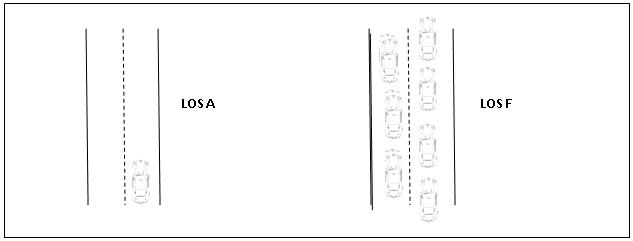
- What are the differences between the two roads from question 3? (Answer: The LOS A road has little to no traffic, the car has room to drive without any interferences by other vehicles, while the LOS F road has tight, bad bumper-to-bumper traffic and too many cars.)
Subscribe
Get the inside scoop on all things TeachEngineering such as new site features, curriculum updates, video releases, and more by signing up for our newsletter!More Curriculum Like This

Expanding on the topic of objects in motion covering Newton's laws of motion, acceleration and velocity, which are taught starting in third grade, students are introduced to new concepts of speed, density, level of service (LOS) (quality of roadways), delay and congestion.

Students learn about the basics of molecules and how they interact with each other. They learn about the idea of polar and non-polar molecules and how they act with other fluids and surfaces. Students acquire a conceptual understanding of surfactant molecules and how they work on a molecular level. ...
References
Winston, Clifford, and Ashley Langer. "The Effect of Government Highway Spending on Road Users' Congestion Costs." Journal of Urban Economics (2006). AEI-Brookings Joint Center. Web. 13 Oct. 2009. http://www.brookings.edu/views/papers/winston/200605-aeijc.pdf
Harrington, Winston, Alan J. Krupnick, and Anna Alberini. "Overcoming Public Aversion to Congestion Pricing." (1998). Resources for the Future. Web. 13 Oct. 2009. http://www.rff.org/rff/Documents/RFF-DP-98-27.pdf
Transportation Research Board. (2000). Highway Capacity Manual 2000. National Research Council, Washington, DC
Copyright
© 2013 by Regents of the University of Colorado; original © 2010 College of Engineering, University of South FloridaContributors
Javier Fuentes; Patricio Rocha; Tapas K. Das; Dayna Lee MartinezSupporting Program
STARS GK-12 Program, College of Engineering, University of South FloridaAcknowledgements
This curriculum was developed by the USF Students, Teachers and Resources in Sciences (STARS) Program under National Science Foundation grant numbers DGE 0139348 and DGE 0638709. However, these contents do not necessarily represent the policies of the NSF, and you should not assume endorsement by the federal government.
Last modified: March 17, 2018







User Comments & Tips